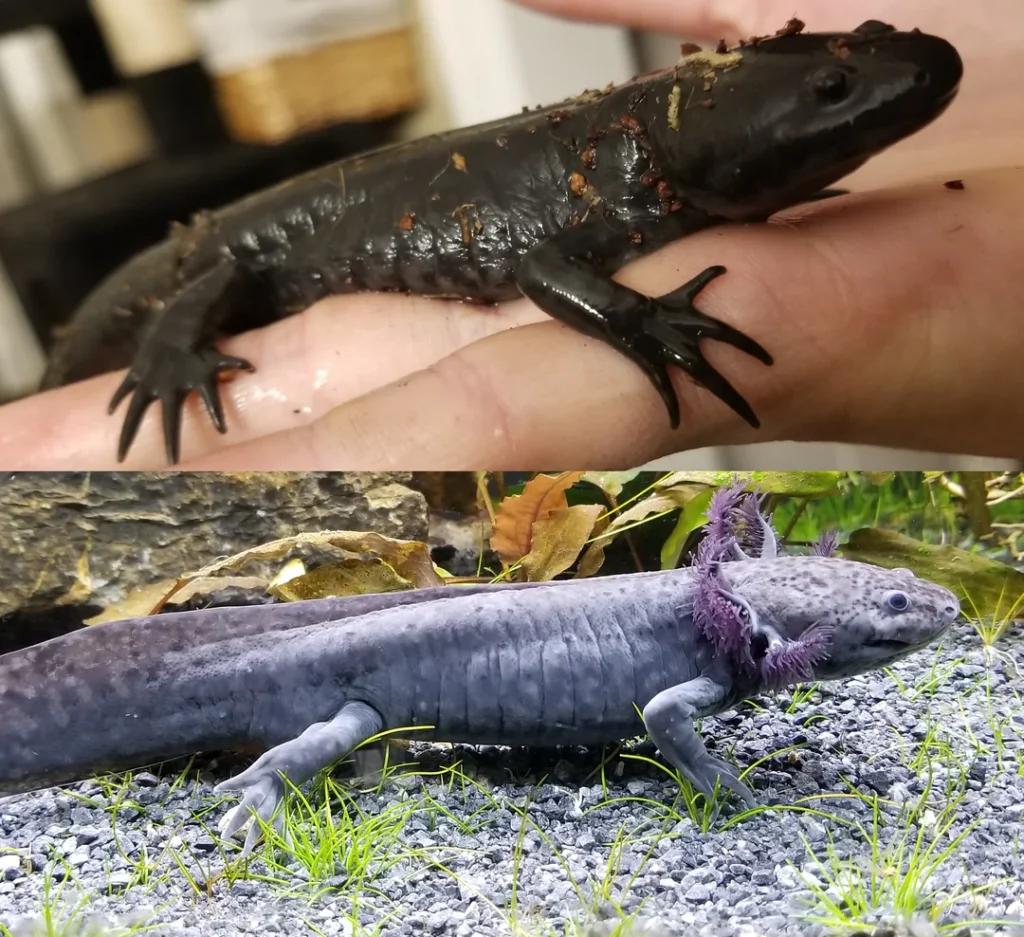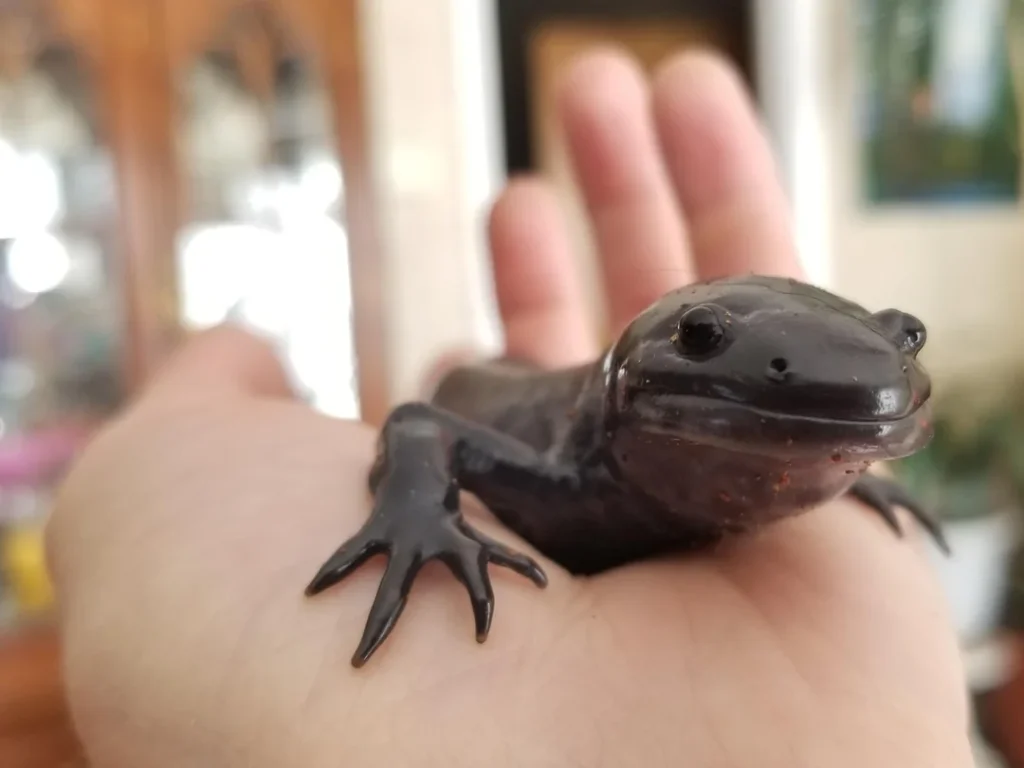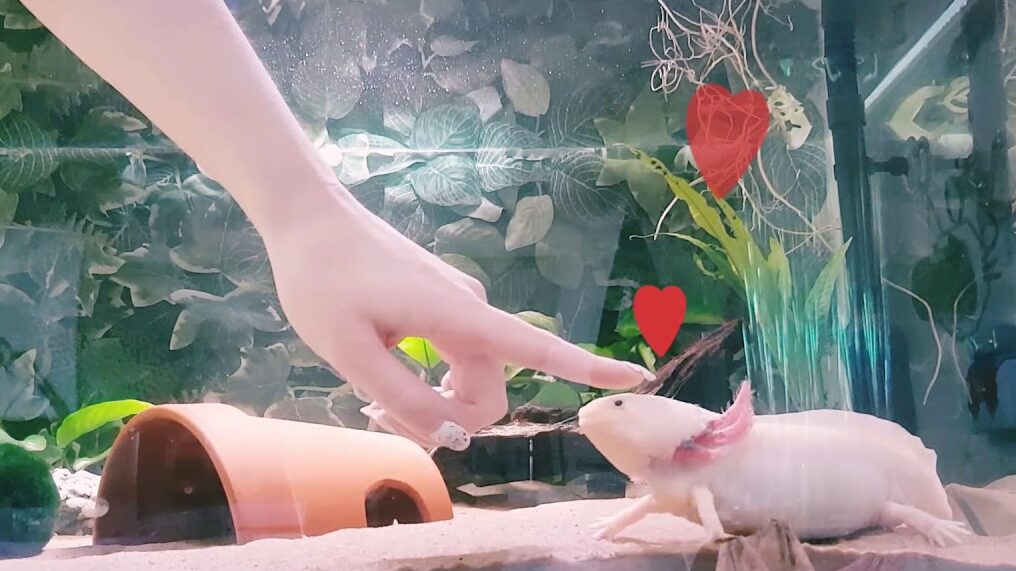
The enigmatic axolotl, native to the ancient waterways of Mexico, is renowned for its unique ability to remain in a perpetual state of adolescence. However, the seemingly magical creature can indeed undergo a remarkable transformation—turning into a salamander. This process, known as neotenic metamorphosis, is not a common occurrence but can be influenced by a variety of factors. Understanding why axolotls make this extraordinary leap is a journey into the complex dynamics of their biology. “Can Axolotls Turn Into Salamanders”
Reasons Why Axolotls Turn Into Salamanders
Metamorphosis in axolotls is a finely orchestrated dance of biological triggers. Hormonal changes, often linked to the maturation process, play a pivotal role. Environmental factors, such as changes in temperature and water quality, can act as catalysts. From an evolutionary standpoint, this metamorphosis is part of the axolotl’s adaptive mechanisms. It allows them to thrive in different ecological niches and is a testament to the incredible flexibility embedded in their genetic code.
Metamorphosis Triggers
The metamorphosis journey commences with a symphony of hormonal changes within the axolotl’s body. Increased levels of thyroid hormones, triggered by environmental cues, signal the initiation of transformation. Temperature fluctuations, particularly higher temperatures, act as a significant trigger, mimicking the seasonal changes in their natural habitat. The intricate interplay between genetics and environmental stimuli creates a delicate balance, dictating whether an axolotl will remain forever young or embark on the path of metamorphosis.
Natural Life Cycle
The metamorphosis of axolotls can be viewed through the lens of their natural life cycle. While their neotenic state is a marvel in itself, metamorphosis serves as a survival strategy. In the wild, where environmental conditions can be unpredictable, the ability to transform into a salamander provides axolotls with versatility. This evolutionary trait enhances their chances of survival and successful reproduction, ensuring the continuation of their species.
Health and Stress Factors
In the realm of axolotls, well-being is intertwined with the prospect of metamorphosis. Health issues and stress can act as triggers for this transformation. Axolotls experiencing compromised health may undergo metamorphosis as a last-ditch effort to adapt to challenging conditions. Stress-induced metamorphosis is a response to environmental disturbances, urging caretakers to be vigilant in maintaining optimal tank conditions. Recognizing signs of stress and providing timely intervention can be crucial in preserving the unique neotenic characteristics of these captivating creatures.
At What Age Do Axolotls Turn Into Salamanders?
The age at which axolotls embark on their transformative journey into salamanders is a captivating aspect of their life cycle. Unlike many creatures with fixed stages of development, axolotls exhibit remarkable variability in the timing of metamorphosis. The answer to this question is not a simple number but a complex interplay of age-related factors and environmental influences.
Age-Related Factors
Axolotls, fascinating in their ability to retain juvenile features, typically begin their lives in a state of aquatic adolescence. The age at which they may undergo metamorphosis varies widely, influenced by both genetic and individual factors. While some axolotls may retain their aquatic form for several years, others might initiate metamorphosis at a relatively younger age. Genetic predisposition plays a role, with certain individuals exhibiting a propensity for early or delayed maturation.
Environmental Influence
Environmental conditions play a pivotal role in shaping the developmental trajectory of axolotls. The aquatic environment serves as a canvas upon which the age-related factors paint their effects. Temperature is a key environmental variable influencing metamorphosis. Higher temperatures, often associated with the changing seasons, can act as a trigger for the onset of metamorphosis. The photoperiod, or the duration of light exposure, also contributes to the environmental cues guiding axolotl development.
Understanding the delicate balance between age-related factors and environmental influences provides insight into the adaptable nature of axolotls. Caretakers and enthusiasts alike are drawn into a dynamic world where the timing of metamorphosis becomes a unique and intriguing facet of these extraordinary creatures’ lives. It emphasizes the importance of creating stable and suitable environments that respect the individual developmental pace of each axolotl, ensuring a harmonious balance between nature and nurture.
How to Stop Axolotls from Turning Into Salamanders
Preserving the aquatic charm of axolotls and preventing them from transforming into salamanders involves a delicate balance of environmental, nutritional, and health considerations. While metamorphosis is a natural phenomenon, providing optimal care can mitigate the triggers that lead to this transformation.
Preventing axolotls, including White Albino Axolotls, from turning into salamanders involves maintaining an aquatic habitat and avoiding specific triggers. Keep water temperatures cool, provide hiding spots, and refrain from stressing them. Ensuring the Best Tanks for Axolotl and meeting their specific needs discourages metamorphosis, allowing them to thrive in their aquatic form.
Optimal Tank Conditions
Creating and maintaining optimal tank conditions is paramount in preventing axolotls from undergoing metamorphosis. Temperature control is a key factor, as higher temperatures can stimulate the hormonal changes that initiate the transformation. Keeping the tank cool, typically around 60-70 degrees Fahrenheit, replicates the axolotl’s natural habitat and reduces the likelihood of triggering metamorphosis. Additionally, ensuring clean and well-oxygenated water contributes to a stress-free environment.
Nutritional Considerations
A well-balanced diet is a crucial aspect of preventing axolotls from turning into salamanders. Providing a variety of nutritious foods, such as live or frozen worms, brine shrimp, and commercial axolotl pellets, supports their unique dietary needs. Proper nutrition not only promotes overall health but also contributes to the maintenance of neotenic features. Axolotls are voracious eaters, and offering a diverse and nutritious diet ensures they receive the essential nutrients required for their well-being.
Monitoring Health Signs
Vigilant monitoring of axolotls’ health signs is an essential practice for preventing metamorphosis. Changes in behavior, appetite, or skin texture can be indicators of stress or underlying health issues. Stress is a significant factor in triggering metamorphosis, and addressing its root causes is crucial. Regular health check-ups, both visually and behaviorally, allow caretakers to intervene promptly, ensuring that axolotls remain in their aquatic form.
Is Turning of Axolotls Into Salamanders Rare?

The transformation of axolotls into salamanders is a captivating aspect of their biology, prompting the question of its rarity. While axolotls are renowned for their ability to retain juvenile features throughout their lives, the occurrence of metamorphosis varies and can be influenced by factors such as genetics, environment, and stress. Understanding the frequency of this transformation provides insights into the dynamic nature of axolotl biology.
The natural lifespan of axolotls, including Axolotl, is not typically characterized by turning into salamanders. In fact, the metamorphosis process is relatively rare in captivity, as it requires specific environmental triggers. Proper care, including the Best Tanks for Axolotl, minimizes the likelihood of this transformation, allowing axolotls to thrive in their unique aquatic state.
Frequency in Captivity
In captivity, the frequency of axolotls turning into salamanders can be influenced by the stability of their environment. When kept in well-maintained tanks with optimal conditions, the likelihood of metamorphosis decreases. However, variations in care practices, such as inconsistent temperature control or inadequate nutrition, can increase the chances of axolotls undergoing this transformation. Knowledgeable and attentive caretaking is essential to maintaining axolotls in their neotenic state.
Wild Population Dynamics
In the wild, the dynamics of axolotl populations further highlight the intriguing nature of this species. Historically native to the ancient waterways of Mexico, wild axolotls face unique challenges. Human-induced changes to their habitat, pollution, and competition with other species contribute to fluctuations in wild axolotl populations. Understanding the interplay between environmental factors and the potential for metamorphosis in the wild provides a holistic perspective on the conservation challenges facing these remarkable creatures.
The rarity of axolotls turning into salamanders is a testament to the intricate balance of nature. While their neotenic characteristics captivate enthusiasts, the possibility of metamorphosis adds a layer of complexity to their existence. Whether in captivity or the wild, the frequency of this phenomenon underscores the importance of responsible care and conservation efforts to ensure the continued wonder of axolotls in their unique aquatic form.
FAQs
Q: Why do axolotls undergo metamorphosis?
A: Metamorphosis is triggered by hormonal changes and environmental factors, often associated with the natural life cycle.
Q: At what age do axolotls typically undergo metamorphosis?
A: Axolotls can start the metamorphosis process at various ages, influenced by both genetic and environmental factors.
Q: Can I prevent my axolotl from turning into a salamander?
A: Maintaining optimal tank conditions, providing a balanced diet, and monitoring health can help reduce the likelihood of metamorphosis.
Q: Are there signs that my axolotl is stressed and may undergo metamorphosis?
A: Yes, signs of stress include abnormal behaviors, loss of appetite, and changes in skin texture. Prompt action can help prevent metamorphosis.
Q: Does the frequency of axolotls turning into salamanders vary in captivity and the wild?
A: Yes, the frequency may vary, with captive axolotls experiencing different conditions than their wild counterparts.
Q: How does temperature affect axolotl metamorphosis?
A: Temperature plays a crucial role, with higher temperatures often triggering metamorphosis. Maintaining a cooler environment is advisable.
Q: Can I revert a salamander back to an axolotl through environmental changes?
A: Once metamorphosis is complete, reverting to an axolotl state is unlikely. Prevention is key.
Q: Are there genetic factors that determine metamorphosis in axolotls?
A: Yes, genetics can influence the likelihood and timing of metamorphosis in axolotls.
Q: How can I ensure a balanced diet for my axolotl?
A: Providing a variety of nutritious foods, including live and commercially prepared options, helps maintain a balanced diet.
Q: Can stress-induced metamorphosis be reversed with proper care?
A: In some cases, addressing the underlying causes of stress and providing optimal care may help revert an axolotl to its original state.
Conclusion
In conclusion, the enigmatic world of axolotls unveils a narrative of biological wonder, adaptation, and the delicate dance between neoteny and metamorphosis. While axolotls are celebrated for their remarkable ability to defy the typical life cycle and remain in a perpetual state of adolescence, the transformation into salamanders adds a layer of intrigue to their story. Understanding the reasons behind this metamorphosis, the factors influencing its timing, and the methods to prevent it has allowed caretakers and enthusiasts to engage in responsible and attentive axolotl stewardship.
The rarity of axolotls turning into salamanders, both in captivity and the wild, highlights the importance of providing optimal conditions for these unique creatures. In captivity, frequency is influenced by factors like temperature control, nutrition, and attentive health monitoring. Meanwhile, wild population dynamics underscore the challenges these amphibians face in their natural habitats.
With 3 years of devoted companionship alongside my aquatic friend, Bob, I’ve gained profound insights into the captivating world of fishkeeping. From understanding behavior to ensuring optimal health, my journey with Bob has enriched my expertise in all things aquatic.




Pingback: How to Set Up an Axolotl Tank? 5 Steps Process - Fish Hue
Pingback: Can Axolotl Live with Other Fish - Fish Hue